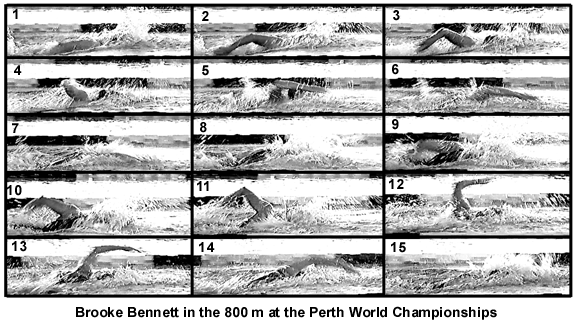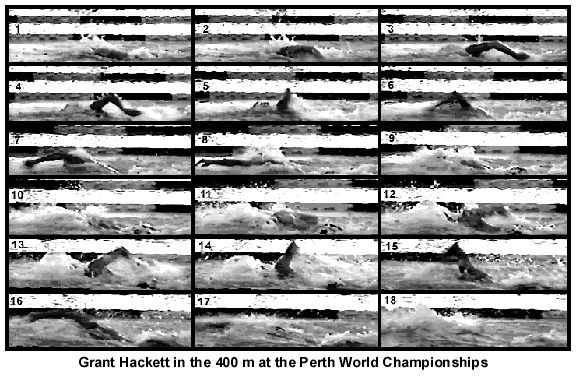

FACTORS INVOLVED IN CRAWL STROKE RECOVERY MOVEMENTS
The arm recovery movement in crawl stroke should fit certain parameters but rarely will two individuals have the same action. Recovery movements will be governed by a swimmer's flexibility, physical structure (e.g., arm length), intended speed of movement, and stroke mechanics (sometimes it is not possible to tell if the recovery is reacting to the pull or the pull reacting to the recovery). A major cause of variation is the technique a swimmer has learned. Some movements are not particularly efficient but persist in a swimmer's style because of substantial conditioning.
When a swimmer is suspended in water, angular movements balance each other around the center of buoyancy. When an arm sweeps to the side, some other action has to be performed to counter-balance that movement, otherwise there will be distortions in the posture or location of the swimmer. A sweep of the right arm to the side usually requires the left arm to match lateral force components to keep the body streamlined. Both Jenny Thompson and Michael Klim press outward and down after entry to balance their tendencies to recovery outward and upward upon exiting the water. If there were no counter-balancing movement, the orientation of the body would skew to the left because of the Third Law of Angular Motion.
Sprinters are usually intent on performing actions with a high magnitude of force, whereas distance-swimmers are more deliberate and protective of their actions because energy sparing is a major part of their events. Ballistic movements assist sprinters. Their recoveries are likely to be more sweeping than that seen among most distance competitors. However, there are exceptions to these generalizations.
Major Mechanical Guidelines for the Crawl Stroke Recovery
The first mechanical guideline of crawl stroke recoveries is "REDUCE LATERAL FORCES." Any movement to the side will use energy in a direction that is not appropriate for forward progression. Lateral movements waste energy in two ways: i) the energy needed to move to the side, and ii) the counter-balancing movement in the other direction (it is required to maintain streamline and progression in the desired direction). Both Jenny Thompson and Michael Klim exhibit these movements particularly during the initial reposition phase of their underwater stroking action. In swimmers who demonstrate this action, it is often called "outsweep." It is preferable to teach swimmers actions that move more along the line of progression than away from it.
The second mechanical guideline is "REDUCE LEVER LENGTH." In crawl stroke, it is very difficult to recover the arms vertically (as in backstroke). Consequently, they are almost invariably pitched to the side. When an arm is held almost straight at a maximum recovery angle of close to 40 degrees (e.g., Michael Klim), the lever arm is large. The effort to hold the arm's weight at that angle is quite high. Sweeping, long-arm recoveries are fatiguing because of the extra effort they demand. If bending at the elbow shortens the lever, the effort to hold the position is less than when straight. In most crawl strokes, an elbow bend is necessary to conserve energy. While sprinters frequently employ ballistic actions in crawl stroke recoveries, even then the arms are usually bent at the elbow. In general, long arm recoveries are more fatiguing than bent arm recoveries.
The third mechanical guideline is "REDUCE VERTICAL FORCES." This could be a guideline that pervades all strokes, not just crawl. High (more vertical) recoveries with long arms will produce greater downward forces than high bent-arm movements. Bigger reaction movements, one example being a deeper pulling pattern, are elicited, and wastefully consume energy when pronounced vertical force components are generated.
Possible Actions for a Better Crawl Stroke Recovery
Not all the following features will apply to every swimmer. Appropriate technique features should be taught to optimize each swimmer's technique.

Figure 1. Alexandre Popov (top left) and Michael Klim (bottom right) at 75 meters in the 100 meters final at the 1998 Perth World Championships. Popov's arm is fully bent at mid-recovery (frame #1). His upper arm is almost vertical. After that position, his hand pushes straight forward as the arm reaches forward over the water surface. His entry is long forward with the hand flat and the fingertips entering first (frame #6). Michael Klim's straight arm exit is shown in frame #1. From there a long sweeping sideways movement is made (frame #3) finishing with a "cocked wrist" prior to entry (frame #6). It is proposed the Popov's recovery is more desirable than Klim's.
The following illustrations demonstrate the recovery actions of two champion distance-swimmers.

Figure 2. Brooke Bennett's recovery in the fifth lap of her 800-m Gold Medal performance at the 1998 Perth World Championships. Frame #1 shows the right arm exit following a long round-out movement underwater. The elbow leads. As the recovery progresses the hand stays low and follows a "direct" movement path. The action is one that emphasizes going forward and minimizing sideways thrusts. The left arm emerges with a greater bend than the right. Frame #12 shows an unnecessary hand "skying" action. The hands are relatively flat and led by the fingers approaching entry.

Figure 3. Grant Hackett's recovery in the fourth lap of his 400-m Silver Medal performance at the 1998 Perth World Championships. Each frame is 1/15th of a second apart. The left arm (frames #1-#9) and right arm (frames #11-#17) exhibit good mechanics. Lateral and vertical movements are minimal.
Instructional Cues
The following factors are cues that a coach might consider when instructing crawl stroke recovery movements.
These factors should be adapted to each individual's physical structure. If a swimmer resists changes or finds them difficult, the coach should look at the swimmer's underwater stroke for dominant actions that cause the recovery to be primarily counter-balancing movements. If that were the case it would be difficult to change the recovery without first changing the underwater movement pattern.
Crawl stroke recoveries will take a variety of forms but they should largely adhere as close as possible to the mechanical principles discussed above.
The importance of the crawl stroke recovery should be placed in perspective. Since it cannot produce propulsive forces, it is less important than what happens underwater. Many coaches emphasize irrelevant cosmetic recovery features (e.g., the position of the little finger, the angle of the hand), as well as imposing detrimental actions (e.g., the hand entering alongside the head and sliding forward underwater, gliding). A recovery should be a natural, simple action and does not need to be unnecessarily complicated by dubious coaching beliefs and instructions.
Return to Table of Contents for Carlile Coaches' Forum.
